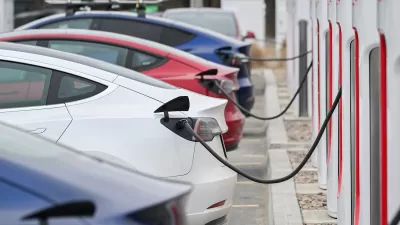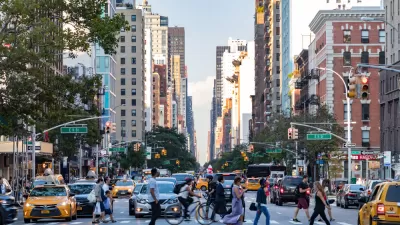With jaywalking enforcement policies recently making news in New York City and Los Angeles, more of the media is pushing back on long-held assumptions about who rules the road. Here’s a primer on how jaywalking became a crime.
With the recent conversation about jaywalking enforcement in New York City and Los Angeles as a back-drop, Aidan lewis provides a sweeping history of how the term “jaywalking” came to be a cultural signifier for “ignorant” and then, finally, a crime.
Lewis quotes Peter Norton, a history professor at the University of Virginia and author of Fighting Traffic - The Dawn of the Motor Age in the American City throughout the article, first to describe the origins of the term “jaywalking”: “The word was first used to describe ‘someone from the countryside who goes to the city and is so dazzled by the lights and the show windows that they keep stopping and getting in the way of other pedestrians’.”
Of course, the incredibly powerful auto industry lobby has a lot to do with the prohibition of jaywalking: “A key moment, says Norton, was a petition signed by 42,000 people in Cincinnati in 1923 to limit the speed of cars mechanically to 25mph (40kph). Though the petition failed, an alarmed auto industry scrambled to shift the blame for pedestrian casualties from drivers to walkers.”
Then clowns were employed to “portray jaywalkers as a throwback to rural, ignorant, pre-motor age ways,” and Boy Scouts handed out fliers to pedestrians to inform them of the rightful position on the street (i.e., the sidewalk).
The anti-jaywalking agenda also infiltrated newspapers and education, et voilà: “Anti-jaywalking laws were adopted in many cities in the late 1920s, and became the norm by the 1930s.”
FULL STORY: Jaywalking: How the car industry outlawed crossing the road

Planetizen Federal Action Tracker
A weekly monitor of how Trump’s orders and actions are impacting planners and planning in America.

Restaurant Patios Were a Pandemic Win — Why Were They so Hard to Keep?
Social distancing requirements and changes in travel patterns prompted cities to pilot new uses for street and sidewalk space. Then it got complicated.

Map: Where Senate Republicans Want to Sell Your Public Lands
For public land advocates, the Senate Republicans’ proposal to sell millions of acres of public land in the West is “the biggest fight of their careers.”

Maui's Vacation Rental Debate Turns Ugly
Verbal attacks, misinformation campaigns and fistfights plague a high-stakes debate to convert thousands of vacation rentals into long-term housing.

San Francisco Suspends Traffic Calming Amidst Record Deaths
Citing “a challenging fiscal landscape,” the city will cease the program on the heels of 42 traffic deaths, including 24 pedestrians.

California Homeless Arrests, Citations Spike After Ruling
An investigation reveals that anti-homeless actions increased up to 500% after Grants Pass v. Johnson — even in cities claiming no policy change.
Urban Design for Planners 1: Software Tools
This six-course series explores essential urban design concepts using open source software and equips planners with the tools they need to participate fully in the urban design process.
Planning for Universal Design
Learn the tools for implementing Universal Design in planning regulations.
Heyer Gruel & Associates PA
JM Goldson LLC
Custer County Colorado
City of Camden Redevelopment Agency
City of Astoria
Transportation Research & Education Center (TREC) at Portland State University
Camden Redevelopment Agency
City of Claremont
Municipality of Princeton (NJ)





























